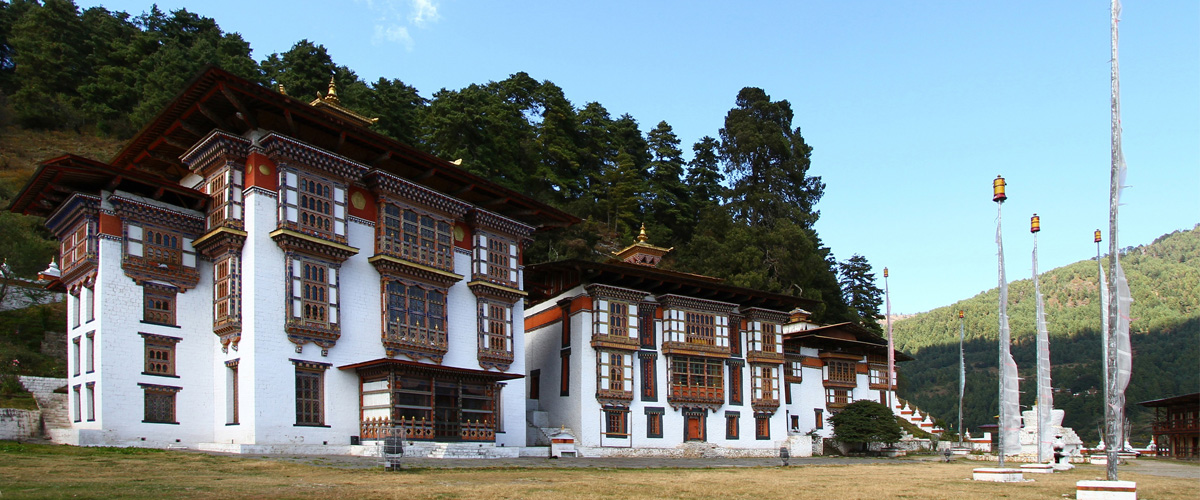Bumthang (2,800m / 9,185ft)
Bumthang is a district located in central Bhutan, known for its stunning landscapes, rich cultural heritage, and spiritual significance. It comprises four major valleys: Chokhor, Tang, Ura, and Chhume, each offering unique experiences ranging from ancient temples and monasteries to picturesque meadows and traditional Bhutanese architecture. Bumthang is often referred to as the "cultural heartland" of Bhutan due to its historical importance as a center for Buddhism and the seat of many important religious festivals and events.
1. Kurjey Lhakhang:

Kurjey Lhakhang holds significant religious importance as one of Bhutan's most sacred sites, associated with Guru Rinpoche, the legendary figure who introduced Buddhism to Bhutan in the 8th century. The name "Kurjey" translates to "body imprint," referring to the imprint of Guru Rinpoche's body said to be left in a rock after he meditated there. The complex includes three main temples surrounded by serene natural beauty, making it a place of pilgrimage and spiritual retreat.
2. Jambay Lhakhang:
Jambay Lhakhang built in the 7th century by Tibetan King Songtsen Gampo, it is one of the 108 temples he constructed to subdue an ogress obstructing the spread of Buddhism. The temple is renowned for its sacred relics and the annual Jambay Lhakhang Drup festival, featuring mask dances and religious rituals. It holds significant cultural and religious importance in Bhutanese history and is a popular pilgrimage site.
3. Jakar Dzong:

Jakar Dzong, also known as the "Castle of the White Bird," is a historic fortress and monastery located in the Bumthang Valley of central Bhutan. It was founded in 1549 by the Tibetan Lama Ngagi Wangchuck, establishing it as an important center of Buddhist learning and governance in the region. Overlooking the picturesque valley, Jakar Dzong is renowned for its unique architecture characterized by large white walls and towering structures, showcasing Bhutanese traditional craftsmanship. Today, it continues to serve as both a religious center and an administrative headquarters for the district of Bumthang.
4. Tamshing Lhakhang:
Tamshing Lhakhang, founded in 1501 by the renowned Bhutanese saint Pema Lingpa, is celebrated for its ancient wall paintings depicting the life of Buddha and the teachings of Guru Rinpoche (Padmasambhava). It is regarded as one of the most significant Nyingma religious institutions in Bhutan, serving as a hub for Buddhist learning and practice. With its distinctive architectural style and profound spiritual significance, Tamshing Lhakhang stands as a prominent cultural heritage site in Bhutan.
5. Mebar Tsho (Burning Lake):
Mebar Tsho, also known as the Burning Lake is renowned for its spiritual significance and natural beauty. The lake earned its name due to a legend involving a Buddhist saint, Pema Lingpa, who is said to have jumped into the lake holding a butter lamp and emerged with it still burning, demonstrating his spiritual powers. Mebar Tsho is considered a pilgrimage site and a place of deep religious importance in Bhutanese culture, attracting both pilgrims and tourists seeking spiritual solace and natural tranquility amidst the Himalayan landscapes.
6. Kenchogsum Lhakhang:
Despite its origins in the 6th century, this temple received a modern renovation in 1995. According to legend, the lhakhang once contained a large bell that rang so loudly it could be heard all the way in Lhasa, Tibet. During the 17th century, marauding Tibetan armies tried to steal the bell, but its weight caused them to drop it, resulting in a crack. Today, this bell is displayed at the national museum in Paro.